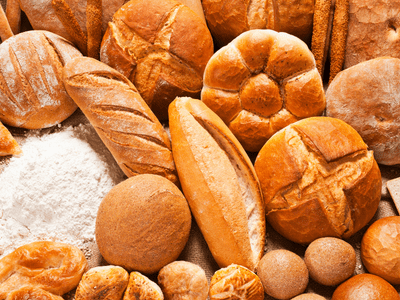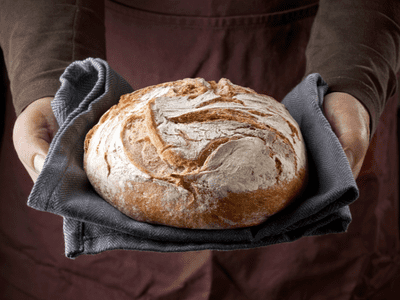The right temperature bake bread-Ultimately, we’re all looking for a perfectly baked loaf of bread, right? When it comes to making and baking bread, temperature is everything. From the water temperature to the dough temperature during the proofing stages, to the oven temperature, and finally the finished product’s internal temperature. Everything contributes to the perfect loaf of bread.
The ideal oven temperature for baking bread is between 350 and 475°F (180 and 246°C), which optimizes both caramelization and the Maillard reaction (which we’ll discuss later), resulting in the perfect color and texture in the finished product. The temperature range can be fine-tuned to suit the type of bread being baked.
Whether you’re baking a loaf of sourdough bread, a loaf of high-fat bread, a sweet bread, or a loaf of rich-dough bread, each has an ideal oven temperature for producing the heavenly results we all seek when baking bread.
Soft crusted bread should be baked at a lower temperature, while thick and crusty bread should be baked at much higher temperatures, according to a cute unwritten rule.
The Maillard Reaction and Caramelization

First and foremost, it is critical to comprehend the mechanisms of caramelization and the Maillard reaction. Color, texture, and flavor would be lacking without the intricate interplay of the two.
What exactly is caramelization?
Caramelization is a complex series of reactions that occur when sugars are used. It is the high-temperature decomposition of sugars.
What Is the Process of Caramelization?
Caramelization occurs with the majority of sugars. The temperature required varies depending on the type of sugar used (e.g., sugar, honey, etc.) and occurs at higher temperatures. Sugars begin to break down at around 350°F (176.6°C), and depending on the time and temperature, caramelization can produce a variety of colors ranging from yellow to brown, to burnt black, and any shade in between.
Bread Caramelization Effect
This is responsible for the caramel flavor (ha! ), nutty and toasty aromas of baked goods, and the caramelized color.
What exactly is the Maillard Reaction?
The Maillard reaction, like caramelization, causes baked goods to brown.
What is the Maillard Reaction?
Sugar-containing foods, whether baked or cooked, bind with amino acids, resulting in a variety of distinct flavors and aromas. The average temperature for the reaction to take place ranges from 280 to 330°F (137.8 to 165.5°C).
Bread and the Maillard Reaction
The Maillard reaction occurs in the curst, resulting in a brown and tasty bread crust.
You’ll notice that the temperature required for the Maillard reaction to occur is lower than that required for caramelization. This is not to say that the Maillard reaction will not occur in conjunction with caramelization; it will. This is why it’s critical to bake your bread at the proper temperature to take advantage of caramelization and the Maillard reaction for the best flavors, texture, and overall appearance.
Different Temperature Bake Bread

So, now that we’ve covered both caramelization and the Maillard reaction, you can see why some breads may require baking at higher or lower temperatures (clearly sugar plays a role). However, sugar is not the only important factor here; other factors include fat content, sourdoughs, and the use of rich ingredients such as milk, butter, and eggs.
Bread with Sourdough
According to rumor, baking an awesome loaf of sourdough bread requires baking it hot and steamy. This ensures a crisp and crunchy crust with excellent oven spring. How high, you might ask? We’re talking temperatures of up to 500°F (260°C), though not all ovens, especially non-industrial ones, are designed to reach such temperatures. However, you can achieve exceptional results in one of two ways:
Results of the Method 1 Heat the oven to 464°F (240°C). Bake for 20 minutes, then reduce to 430°F (220°C), and bake for another 15 minutes. This results in a darker, thicker crust. 2 Preheat the oven to 430°F (220°C) and bake for 40–45 minutes. This results in a thinner, lighter-colored crust.
TIP: To see if your loaf of bread is fully baked, flip it over and knock on it; if it feels soft and hollow, it’s done. If it doesn’t, return it to the oven for a few minutes longer.
Steam
Creating steam in your oven both before and during baking results in a nice crunchy and glistening crust. Steam in the oven prevents the crust from baking too quickly, allowing the dough to continue expanding and rising to its full potential. It contributes to the crust’s deep golden color as well as its shiny coating. Place a pan of water in the oven, spray water on the side of the oven and close the door, or even place a bowl of ice cubes in the oven to create steam.
If you want to learn all of the best hacks for producing the perfect steam for your bread, all of which are super simple to implement, I recommend you check out this post right here.
Bread Stone / Cast Iron Pan
Placing a cast iron pan, bread stone, or pizza stone in your oven while it preheats and then placing your dough on it before baking provides an immediate blast of heat to the dough. This allows the dough to start rising before the crust forms.
When it comes to baking bread, I always use a cast iron pan. I’ve had quite a few of them over the years, some more expensive than others. I’ve been using A pot, which I highly recommend, in recent years. It provides excellent value for money as well as extremely tasty results. If you want to learn more about it, read this post.
If you’re looking for a crispy crust, look no further than this super informative post right here.
Bread Made from Fat
“Rich-dough” bread contains a fat, such as oil, butter, or another type of fat. Fat serves several functions in baking. It coats the flour and prevents water and proteins from interacting, causing gluten development to slow. Furthermore, bread containing fat lacks the long gluten strands found in bread made without fat.
A rich-dough bread is typically baked at a lower temperature than a standard yeast bread temperature. Keep in mind, however, that as with any bread recipe, it’s best to stick to the recommended oven temperature to get the best results. If you use a thermometer in your bread baking (which you should, more on that here), consider that rich-dough bread should have an internal temperature range of 180 to 190°F (82 to 88 °C) at the end of baking.
Bread Made from Sugar
Sugars in bread, such as white and brown sugar, honey, molasses, syrups, and so on, are used to add flavor and sweetness, such as through caramelization. Furthermore, sugar serves as food for yeast during the fermentation process in a loaf of yeast bread. Bread with more than a 12 cup of sugar is typically baked at 350°F (177°C), whereas bread with less than a 12 cup of sugar is typically baked at 375°F (191°C).
TIP: The darker the sugar you use (i.e., molasses, brown sugar, etc.), the faster your bread will brown during baking. You can control the resulting color and prevent it from becoming over-browned if you preheat your oven and then bake at a slightly lower temperature, by about 25°F (14°C), or carefully observe the last 5 to 10 minutes of baking.
Rich Bread
A rich bread, so named because of the rich ingredients used in the recipe, such as milk, eggs, and butter, varies in oven temperature depending on the recipe.
Brioche
Brioche is classified as a Viennoiserie, which is a baked good leavened with yeast, similar to bread, but with additional ingredients to improve the final product. Brioche is a bread-pastry hybrid that requires butter, eggs, and milk (or cream, water, and occasionally brandy). Depending on the recipe, oven temperatures range from 325 to 375°F (163 to 180°C) and baking times range from 30 to 45 minutes. If you have a bread thermometer, the goal after baking is an internal temperature of about 190°F (88°C).
Milk Bread Hokkaido
Shokupan, also known as Japanese milk bread, is soft and airy due to the unique involvement of a roux-type starter known as a tangzhong. Tangzhong is a simple combination of flour and water that is whisked together in a saucepan and cooked at 149°F (65°C) to gelatinize the starch. The ideal oven temperature for baking Japanese milk bread is 350°F (180°C) for 25 to 40 minutes, depending on your oven. When the bread is done, the digital thermometer should read 190°F (88°C).
The Final Note

In a set-it-and-forget-it mode, we frequently set the oven for bake bread temperature to 350°F (176.6°C) when baking. Or perhaps it was obvious to you that different types of bread require different oven temperatures; either way, learning the complexities of baking bread, as well as the variety of desirable results, can’t hurt, right? We all want our bread to turn out perfectly, and understanding the subtle differences between different types of bread can make all the difference.
The oven temperature is critical during the baking stage, and understanding how it all works is clearly a step in the right direction.
If you want to be consistent and accurate, and achieve great baking results that you can repeat, I highly recommend investing in two inexpensive tools that can improve your baking process. I’m referring to dough and oven thermometers. There are numerous reasons to employ them. They can be of great assistance and ensure that you do not have a baking disaster. If you want to learn more, simply click here and read all about it.
Lastly..
The oven temperature will, of course, vary depending on the type of bread you’re baking. Knowing how your oven works, following the recipe, and, as previously mentioned, owning a digital thermometer are all important when pursuing the perfect baked loaf of bread.